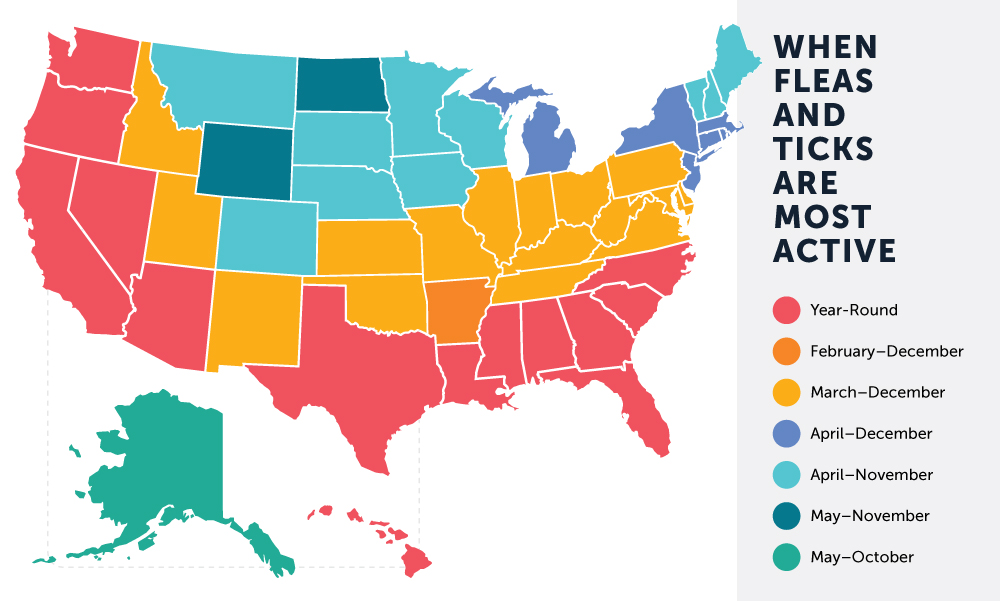When Is Flea Season?

You might be wondering when flea season is in your area of the country. After all, it’s important to keep your pet on a flea and tick preventative when these pests are most prevalent. However, fleas and ticks are a problem for pets year round. Here’s a map showing when you might be most at risk for an infestation:

As you can see, fleas and ticks are most active during the warmer months of the year. In some warm areas of the country, such as the South and West Coast, flea season is year round. In the middle of the US, fleas and ticks are a greater risk generally between March and December. Moving north, flea season gets gradually shorter. All this being said, fleas and ticks can strike any time of year, in any part of the country. So even if it’s an icy-cold February in Alaska, you still might experience a flea infestation or tick bite — it’s just less likely.
Fleas are tough little creatures (the yucky ones always are!). They can live in temperatures as low as the upper 30s and thrive especially when it’s between 65 and 80 degrees Fahrenheit with 75-85% humidity. Fleas simply need an animal host to feed on to survive cold winters.
Flea pupae stay in their cocoons while it’s chilly and emerge when the weather gets warmer, simply biding their time in a warm area, like your basement or garage. These pupae can stay dormant for well over a year until the weather warms up. Then they emerge from their cocoons and that’s when you have an infestation on your hands.
When Does My Pet Need to Be on a Flea and Tick Preventative?
Since these pests just need a warm environment to thrive, a warm home is perfect for fleas to lay their eggs. This is why all pets need to be on flea and tick preventatives all year round — even if you have an indoors-only pet. A warm house is particularly at risk for fleas to be active the entire year.
What Happens If My Pet Isn’t on a Preventative?
Unfortunately, you risk more than just a few itchy bites if you don’t put your pet on a flea and tick preventative. These blood-suckers can spread a variety of serious diseases including:
- Lyme disease
- Babeiosis (similar to malaria)
- Ehrlichiosis (bacterial infection)
- Tick paralysis
Plus, prevention is much, much easier to deal with than extermination. This is a case where defense is the best offense. Giving your pet a topical or oral medication once a month is much, much easier than shampooing your pet and having to rid your entire home of fleas and ticks. These pests don’t just hide on our animals — they also infest carpets, furniture and floorboards. Extermination isn’t just a massive pain. It can also be expensive! You might also have to pay for pricey vet bills. It’s just not worth the risk.
If you already have fleas, here are some products that might help:
- Flea Flicker! Tick Kicker! is a spray that repels and kills fleas and ticks.
- Bio Spot for cats helps kill fleas, ticks and mosquitoes which can transmit heartworm disease.
- Natural Flea Spray for Cats helps protect against fleas, black flies and mosquitoes.
- Carpet Powder is great for killing fleas and ticks living in your carpets and upholstery.
So again, even if you live in a cold area of the country and your pet lives indoors 24/7, they need to be on a flea and tick preventative all year long. Ask your vet about your options and never use a cat preventative on a dog or vice versa.
What kind of flea and tick preventative do you use? Let us know on Facebook!


